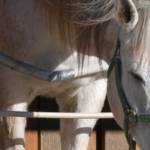Laser Therapy for Tendon and Ligament Injuries in Horses

Time consuming, frustrating, expensive, devastating. This smattering of synonyms serves only as a sampling of words used to describe soft-tissue injuries in horses, often uttered through clenched teeth by owners and veterinarians alike.
“Tendons and ligaments can be injured with a single misstep, leading to a long road to recovery partnered with a high rate of re-injury,” explained Laura Petroski-Rose, B.V.M.S., a veterinarian for Kentucky Equine Research.
The protracted convalescence frequently associated with tendon and ligament injuries stems from the healing process. Instead of healing with normal tendon and ligament fibers arranged perfectly in rows, the horse’s body lays down bundles of scar tissue instead. Scar tissue is much weaker than normal tendon and ligament fibers, making the horse prone to re-injury despite extensive layups and prolonged treatment periods following the original injury.
According to a recent study*, many treatment approaches have been tested with varying results, which explains “the continuous quest for new avenues to treat tendinopathy in horses.”
Examples of those treatment options include:
- Local or systemic administration of anti-inflammatory drugs;
- Corticosteroid administration into the injured tissue;
- Administration of polysulfated glycosaminoglycans (PSGAGs);
- Platelet-rich plasma;
- Autologous conditioned serum;
- Stem cell therapy;
- Surgery (e.g., tendon-splitting, proximal check ligament desmotomy); and
- Shockwave therapy.
On a quest to find a better treatment option, Pluim and colleagues examined the effect of lasers on soft-tissue injuries. The group postulated that laser therapy would be safe and effective for helping soft-tissue injuries heal.
Why lasers?
“Various studies show that laser therapy increases the production of collagen, a key component of soft tissues; improves the alignment of collagen fibers; and increases the strength of tendons. In addition, pro-inflammatory mediators reportedly decrease with laser therapy,” summarized Petroski-Rose.
The researchers note that, although in its infancy, the laser study results were, “encouraging enough to justify a program of prospective studies and controlled experimental studies that can help in obtaining more insight into the biophysical effects of high-power laser therapy on tendon and ligament healing.”
“Owners should always discuss the best treatment options with their veterinarian, including the use of glucosamine and chondroitin sulfate products that support musculoskeletal health and omega-3 fatty acids with natural anti-inflammatory effects. Kentucky Equine Research offers KER-Flex and EO-3 to meet these needs,” Petroski added.
In Australia, look for both EO-3 and Glucos-A-Flex.
*Pluim, M., A. Martens, K. Vanderperren, et al. 2018. Short- and long-term follow-up of 150 sports horses diagnosed with tendinopathy or desmopathy by ultrasonographic examination and treated with high-power laser therapy. Research in Veterinary Science. 119:232-238.








